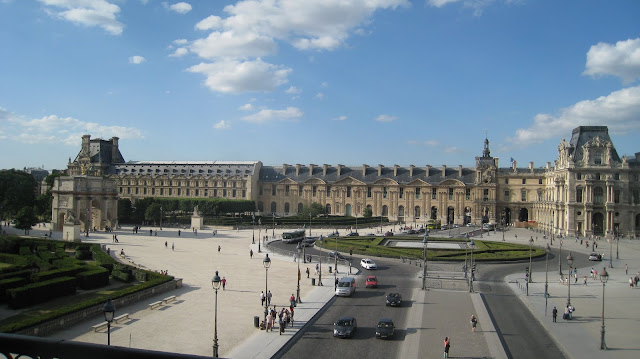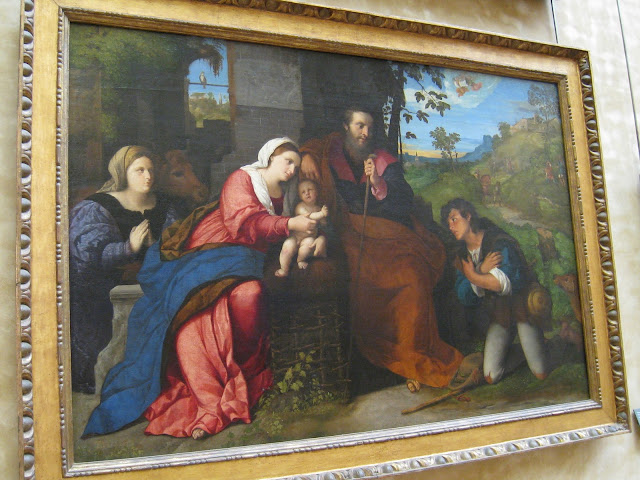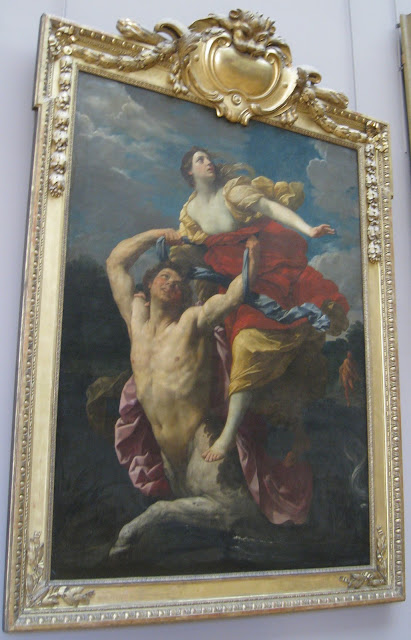The Musee du Louvre (Louvre Museum) is one of the world's largest museums and probably the most famous. It is a very popular tourist destination in Paris, France, and has become the most visited art museum in the world. The Louvre first opened on August 10, 1793, one year after the fall of the French monarchy.
The Pyramide du Louvre (Louvre Pyramid) is a large glass and metal pyramid surrounded by three smaller pyramids in the main courtyard, Cour Napoleon, of the Palais de Louvre (Louvre Palace). The large pyramid and its underground lobby serve as the main entrance to the Louvre Museum. This landmark was designed by the American architect I. M. Pei, and was inaugurated on October 15, 1988. In 1993, the La Pyramide Inversee (Inverted Pyramid) was added.
The Palaise du Louvre (Louvre Palace) is located along the right bank of the Seine River in Paris. It is a vast complex of pavilions and wings on four main levels. This was the official palace of the French Kings until King Louis XIV transferred his official residence to Versailles in 1678. When it bacame a museum, the New Louvre north wing became the Richelieu Wing, the New Louvre south wing became the Denon Wing and the old Louvre became the Sully Wing.
The Arc de Triomphe du Carrousel was constructed between 1806 and 1808 by Emperor Napoleon I (Napoleon Bonaparte) at the Palais du Louvre. Like the Arc de Triomphe de I'Etoile at Place du General Charles de Gaulle, it was erected to commemorate Napoleon's great military victories and the French Grand Armies that he commanded.
Mona Lisa
The Mona Lisa is considered the most famous painting in the world. It is a painting by the Italian artist Leonardo Da Vinci in oil on poplar panel and was completed circa 1503 and 1519. It was originally known as La Gioconda or Portrait of Lisa Gherardini, wife of Francesco del Giocondo. Leonardo Da Vinci, one of the greatest minds of the Renaissance, began painting the Mona Lisa in 1503 and completed before his death in 1519. This painting was among the first portraits to depict the sitter before an imaginary landscape and to use aerial perspective.
Venus De Milo
Aphrodite tes Melou or better known as Venus de Milo is an ancient Greek marble statue and one of the most famous sculptures in the world. Created between 130 and 100 BC, it depicts Aphrodite, the Greek goddess of love and beauty. In the Roman Empire, Venus is the goddess of love and beauty. It is slightly larger than life size at 6 feet 8 inches tall. it is believed to be the work of Alexandros of Antioch. It was discovered by a peasant named Yorgos Kentrotas and a French naval officer, Jules Dumont d'Urville on April 8, 1820 in the ancient city ruins of Milos on the Aegean island of Milos.
The Women of Algiers (In their Apartment)
Femmes d'Alger dans leur appartment (The Women of Algiers in their Apartment) is an oil on canvass painting by Eugene Delacroix in 1834. The painting depicts Algerian concubines of a harem with a hookah, which is used to smoke opium or hashish. The French invasion and occupation of Algeria in 1830 opened a unique opportunity for Delacroix to document the beauty of Northern Africa. He found the atmosphere, the colors, the people and the architecture of this exotic world very exhilarating.
Le Radeau de la Meduse (The Raft of the Medusa) is a famous oil painting by Theodore Gericault (1791-1824), a French Romantic painter. This painting has become an icon of French Romanticism. This is a larger than life size painting (16 feet by 28 feet six inches) which depicts the aftermath of the wreck of the French naval frigate Meduse. In the beginning, at least 147 people were set adrift on the raft, all but 15 died in the 13 days before their rescue.The survivors endured starvation, dehydration, cannibalism and madness.
Jack-Louis David (1748-1825) is considered to be the pre-eminent French painter of the Neoclassical style. Emperor Napoleon I appointed David as the official court painter and commissioned him to paint grandiose paintings to commemorate his triumphs. One of the great works that David was commissioned for was "The Coronation of Napoleon at Notre Dame". Participants in the coronation came to his studio to pose individually except for the Emperor. Even the Pope came and sat for the painting.
Leonidas at Thermopylae (1814)
The Intervention of the Sabine Women (1799)
Portrait of Pope Pius VII
Liberty Leading the People
La Liberty Guidant le Peuple (Liberty Leading the People) is one of the more famous paintings at the Louvre. This popular painting by Ferdinand Victor Eugene Delacroix (1798-1683), a French painter during the Romantic Period, was produced in 1830. This is a huge oil on canvass painting, 8 feet 6 inches by 10 feet 8 inches. This painting romanticized the French Revolution and commemorated the overthrow of the French King Charles X.
The Barque of Dante
The "Barque of Dante", also known as "Dante and Virgil in Hell", is the first major painting by the French artist Eugene Delacroix. It signalled a shift from Neo-Classism to the Romantic Movement. This painting is based on the fictional events taken from Canto Eight of "Dante's Inferno". A leaden, smoky mist and the blazing City of the Dead for the backdrop against which the poet Dante endures the fearful crossing of the River Styx. He is steadied by the learned poet of Antiquity, Virgil, as they plough through waters heaving with tormented souls.
Scène des Massacres de Scio (The Massacre of Chios)
The "Massacre of Chios" is the second major oil painting by the famous French artist, Eugene Delacroix. This painting is over thirteen foot-high and was painted in 1824. The Chios Massacre refers to the slaughter of tens of thousands of Greeks on the island of Chios by military forces from the Ottoman Empire (Modern Turkey) during the Greek War of Independence in 1822. Greeks from neighboring islands arrived on Chios and encouraged the Chians to join the struggle for independence. In response, Ottoman troops landed on the island and slaughtered thousands. The massacre provoked international outrage and led to greater support for the Greek cause worldwide.
The Women of Algiers (In their Apartment)
Femmes d'Alger dans leur appartment (The Women of Algiers in their Apartment) is an oil on canvass painting by Eugene Delacroix in 1834. The painting depicts Algerian concubines of a harem with a hookah, which is used to smoke opium or hashish. The French invasion and occupation of Algeria in 1830 opened a unique opportunity for Delacroix to document the beauty of Northern Africa. He found the atmosphere, the colors, the people and the architecture of this exotic world very exhilarating.
The Raft of the Medusa
The Coronation of Napoleon (1806)
Oath of the Horatii (1784)
This painting occupies an extremely important place in the body of Jacque-Louis David's work and in the history of French painting. The story was taken from Titus-Livy. We are in the period of the wars between Rome and Alba, in 669 B.C. It has been decided that the dispute between the two cities must be settled by an unusual form of combat to be fought by two groups of three champions each. The two groups are the three Horatii brothers and the three Curiatii brothers. The drama lay in the fact that one of the sisters of the Curiatii, Sabina, is married to one of the Horatii, while one of the sisters of the Horatii, Camilla, is betrothed to one of the Curiatii. Despite the ties between the two families, the Horatii's father exhorts his sons to fight the Curiatii and they obey, despite the lamentations of the women.
Leonidas at Thermopylae (1814)
The Intervention of the Sabine Women (1799)
The story for the painting is as follows: "The Romans have abducted the daughters of their neighbors, the Sabines. To avenge this abduction, the Sabines attacked Rome, although not immediately—since Hersilia, the daughter of Tatius, the leader of the Sabines, had been married to Romulus, the Roman leader, and then had two children by him in the interim. Here we see Hersilia between her father and husband as she adjures the warriors on both sides not to take wives away from their husbands or mothers away from their children. The other Sabine Women join in her exhortations."
Portrait of Pope Pius VII
St. Sebastian by Pietro Perugino.
Pietro Perugino(1446-1523) was born Pietro Vannucci in Citta della Pieve, Umbria, Italy. Perugino was one of the earliest Italian oil painters. He apprenticed with Leonardo da Vinci early in his career and became a teacher of Raphael towards the end of his career.



































































































No comments:
Post a Comment